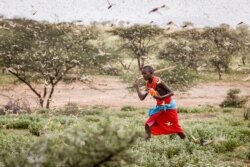A new round of locust swarms has hit Ethiopia and is again threatening crops and food security, say agricultural officials.
Dereje Hirpha, the Oromia region’s head of locust control, tells VOA's Horn of Africa Service that the new generation of locusts was first reported weeks ago in the Raya district and has since spread across thousands of hectares in 40 districts of the region.
The fast-moving swarm is threatening crops in a country where more than 80 percent of the population depends on agriculture for its livelihood.
A similar locust wave hit Ethiopia a year ago. The U.S. Agency for International Development (USAID) has said it believes heavy rainfall in East Africa has contributed to the growth of locust swarms in the area.
This new generation is arriving from Somaliland, while breeding has continued on both sides of the Red Sea, and in Sudan and Eritrea, according to experts.
USAID plans to work with the U.N. Food and Agriculture Organization to prevent and control the spread of locusts, its office of communication says. The agency is training more than 300 pest experts and providing 5,000 sets of protective equipment for locust fighters.
Hirpha says authorities are spraying the affected areas from planes and vehicles on the ground to ward off the pests.
Locals, meanwhile, are engaged in their own combat operation. When a locust swarm approaches, residents try to scare them away by blowing whistles, drumming empty buckets, setting fires, and shooting into the air.
Locust chasers take position in green areas to disperse the swarms before the descend.
"From a distance the swarm looks like a brown cloud, a sandstorm,” says Sora Kura, one of the chasers in the Borana zone.
The swarm follows the wind direction and is also guided by hairy antenna on their heads that detect smells and other signals of food, Hirpha says. According to the FAO, the swarms can move up to 150 kilometers per day.
USAID says the swarms will likely spread next to southwest Ethiopia and northwestern Kenya, and may enter Uganda and South Sudan.
Desert locust can comfortably live in a warm, sandy environment like Eastern Ethiopia and Somaliland, Hirpha says.
Ethiopia has to report any assessment of the crops lost to the pests. In 2003 and 2005, locust outbreaks in more than 20 countries, mainly in North Africa, cost farmers $3.6 billion, according to the FAO.










